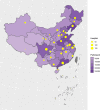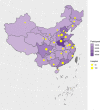China Stroke Statistics 2019: A Report From the National Center for Healthcare Quality Management in Neurological Diseases, China National Clinical Research Center for Neurological Diseases, the Chinese Stroke Association, National Center for Chronic and Non-communicable Disease Control and Prevention, Chinese Center for Disease Control and Prevention and Institute for Global Neuroscience and Stroke Collaborations
- PMID: 32826385
- PMCID: PMC7548521
- DOI: 10.1136/svn-2020-000457
China Stroke Statistics 2019: A Report From the National Center for Healthcare Quality Management in Neurological Diseases, China National Clinical Research Center for Neurological Diseases, the Chinese Stroke Association, National Center for Chronic and Non-communicable Disease Control and Prevention, Chinese Center for Disease Control and Prevention and Institute for Global Neuroscience and Stroke Collaborations
Abstract
China faces the greatest challenge from stroke in the world. The death rate for cerebrovascular diseases in China was 149.49 per 100 000, accounting for 1.57 million deaths in 2018. It ranked third among the leading causes of death behind malignant tumours and heart disease. The age-standardised prevalence and incidence of stroke in 2013 were 1114.8 per 100 000 population and 246.8 per 100 000 person-years, respectively. According to the Global Burden of Disease Study 2017, the years of life lost (YLLs) per 100 000 population for stroke increased by 14.6%; YLLs due to stroke rose from third highest among all causes in 1990 to the highest in 2017. The absolute numbers and rates per 100 000 population for all-age disability-adjusted life years (DALYs) for stroke increased substantially between 1990 and 2017, and stroke was the leading cause of all-age DALYs in 2017. The main contributors to cerebrovascular diseases include behavioural risk factors (smoking and alcohol use) and pre-existing conditions (hypertension, diabetes mellitus, dyslipidaemia and atrial fibrillation (AF)). The most prevalent risk factors among stroke survivors were hypertension (63.0%-84.2%) and smoking (31.7%-47.6%). The least prevalent was AF (2.7%-7.4%). The prevalences for major risk factors for stroke are high and most have increased over time. Based on the latest national epidemiological data, 26.6% of adults aged ≥15 years (307.6 million adults) smoked tobacco products. For those aged ≥18 years, age-adjusted prevalence of hypertension was 25.2%; adjusted prevalence of hypercholesterolaemia was 5.8%; and the standardised prevalence of diabetes was 10.9%. For those aged ≥40 years, the standardised prevalence of AF was 2.31%. Data from the Hospital Quality Monitoring System showed that 3 010 204 inpatients with stroke were admitted to 1853 tertiary care hospitals during 2018. Of those, 2 466 785 (81.9%) were ischaemic strokes (ISs); 447 609 (14.9%) were intracerebral haemorrhages (ICHs); and 95 810 (3.2%) were subarachnoid haemorrhages (SAHs). The average age of patients admitted was 66 years old, and nearly 60% were male. A total of 1555 (0.1%), 2774 (0.6%) and 1347 (1.4%) paediatric strokes (age <18 years) were identified among IS, ICH and SAH, respectively. Over one-third (1 063 892 (35.3%)) of the patients were covered by urban resident basic medical insurance, followed by urban employee basic medical insurance (699 513 (23.2%)) and new rural cooperative medical schema (489 361 (16.3%)). The leading risk factor was hypertension (67.4% for IS, 77.2% for ICH and 49.1% for SAH), and the leading comorbidity was pneumonia or pulmonary infection (10.1% for IS, 31.4% for ICH and 25.2% for SAH). In-hospital death/discharge against medical advice rate was 8.3% for stroke inpatients, ranging from 5.8% for IS to 19.5% for ICH. The median and IQR of length of stay was 10.0 (7.0-14.0) days, ranging from 10.0 (7.0-13.0) in IS to 14.0 (8.0-22.0) in SAH. Data from the Chinese Stroke Center Alliance demonstrated that the composite scores of guideline-recommended key performance indicators for patients with IS, ICH and SAH were 0.77±0.21, 0.72±0.28 and 0.59±0.32, respectively.
Keywords: statistics; stroke.
© Author(s) (or their employer(s)) 2020. Re-use permitted under CC BY-NC. No commercial re-use. See rights and permissions. Published by BMJ.
Conflict of interest statement
Competing interests: All authors declared that they have no financial and personal relationships with other people or organizations that can inappropriately influence their works.
Figures



































Comment in
-
China Stroke Statistics 2019: a wealth of opportunities for stroke prevention.Stroke Vasc Neurol. 2020 Sep;5(3):240-241. doi: 10.1136/svn-2020-000529. Epub 2020 Aug 21. Stroke Vasc Neurol. 2020. PMID: 32826384 Free PMC article. No abstract available.
References
-
- Li X, Zhang X. Annual data set on national mortality surveillance 2018. Beijing: China Science and Technology Press, 2019.
Publication types
MeSH terms
LinkOut - more resources
Full Text Sources
Medical
